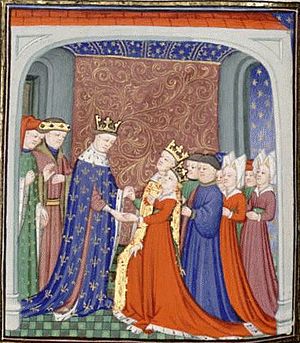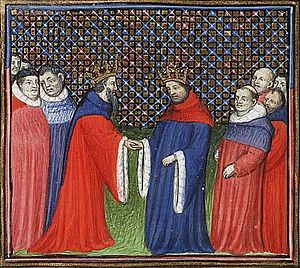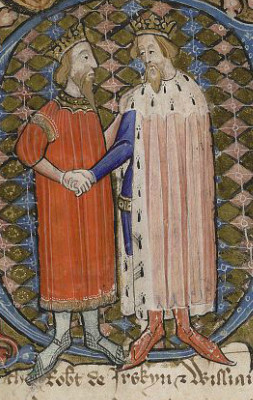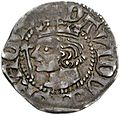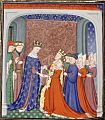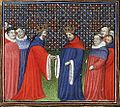David II of Scotland facts for kids
Quick facts for kids David II |
|
|---|---|
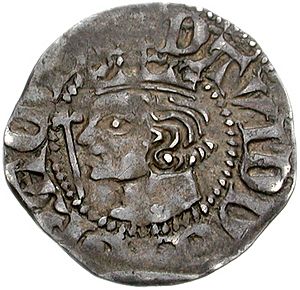
A coin depicting David II
|
|
| King of Scots | |
| Reign | 7 June 1329 – 22 February 1371 |
| Coronation | 24 November 1331 |
| Predecessor | Robert I |
| Successor | Robert II |
| Regents |
See list
|
| Born | 5 March 1324 Dunfermline Abbey, Fife, Scotland |
| Died | 22 February 1371 (aged 46) Edinburgh Castle, Edinburgh, Scotland |
| Burial | Holyrood Abbey |
| Spouse | |
| House | Bruce |
| Father | Robert I of Scotland |
| Mother | Elizabeth de Burgh |
David II (born March 5, 1324 – died February 22, 1371) was the King of Scots from 1329 until his death. He became king at just five years old after his father, Robert the Bruce, passed away. David was crowned at Scone in November 1331. He was the first Scottish king to be anointed with oil during his coronation.
While David was a child, Scotland was ruled by special leaders called guardians. Edward III of England tried to take advantage of David's young age. He supported an invasion of Scotland by Edward Balliol, which started the Second War of Scottish Independence. After the English won the Battle of Halidon Hill in 1333, David and his queen had to go to France for safety. He stayed there until 1341 when it was safe to return home.
In 1346, David invaded England to help France during the Hundred Years' War. His army lost at the Battle of Neville's Cross, and he was captured. David was held prisoner in England for eleven years. During this time, his nephew, Robert the Steward, governed Scotland. In 1357, the Treaty of Berwick ended the war. Scotland agreed to pay a large ransom of 100,000 merks for David's freedom.
David II returned to Scotland, but raising the ransom money was hard. He tried to make a deal with Edward III of England to cancel the ransom. This deal would have made an English prince the next king of Scotland. The Scottish Parliament strongly rejected this idea in 1364. David II worked to make his kingdom strong and improve the government. He died in 1371 without children. His nephew, Robert II, became the next king.
Contents
Early Life and Childhood
David II was born on March 5, 1324, at Dunfermline Abbey in Fife, Scotland. He was one of twin sons born to King Robert I and Elizabeth de Burgh. When he was young, he was cared for by a wet nurse at Inchmurdoch.
In 1326, his father made him Earl of Carrick. A special home was set up for him at Turnberry Castle. We don't know much about his early years. However, King Robert paid for Dominican friars to teach David. He also bought books for him. David's mother passed away in 1327 when he was three years old.
As part of a peace agreement called the Treaty of Edinburgh–Northampton, David married seven-year-old Joan of England. She was the daughter of Edward II of England. They were married on July 17, 1328, at Berwick Castle. They did not have any children.
Becoming King
David became king when his father died on June 7, 1329. He was only five years old. Because he was so young, his coronation was delayed. The seven-year-old king and his wife were crowned at Scone Abbey on November 24, 1331.
After David became king, Thomas Randolph, 1st Earl of Moray was chosen as the Guardian. He was to rule Scotland until David was old enough. The government set up by King Robert I stayed mostly the same. After Moray died in 1332, Donald, Earl of Mar became Guardian. But he died just ten days later at the Battle of Dupplin Moor.
Sir Andrew Murray was then chosen as the new Guardian. He was captured by the English in 1333. Archibald Douglas took over but also died in battle that July.
Meanwhile, Edward Balliol, who was supported by Edward III of England, tried to claim the Scottish throne. He was crowned king by the English in September 1332. But he was soon forced to flee to England. He returned the next year with an English invasion force.
Life in Exile
After the English won the Battle of Halidon Hill in July 1333, David and his wife were sent to France for safety. They arrived in Boulogne on May 14, 1334. King Philip VI welcomed them kindly. David lived at Château Gaillard. Not much is known about his time in France.
By 1341, David's supporters in Scotland had gained control again. David was able to return to his kingdom. He landed at Inverbervie on June 2, 1341. He took control of the government himself at the age of 17.
Captured by England
In 1346, David invaded England. He did this to help France, who was fighting England in the Hundred Years' War. David's army was defeated at the Battle of Neville's Cross on October 17, 1346. David was wounded and captured by Sir John de Coupland.
The king was taken to London and imprisoned in the Tower of London in January 1347. He was later moved to Windsor Castle. David was held captive in England for eleven years.
On October 3, 1357, a treaty was signed at Berwick-upon-Tweed. Scotland's nobles agreed to pay 100,000 marks as a ransom for their king. This was a very large sum of money. The Scottish Parliament approved this agreement.
Back in Scotland
David returned to Scotland right away. He brought with him a mistress, Katherine Mortimer. Her death in 1360 was unclear. She was later replaced by Margaret Drummond.
After six years, Scotland was struggling to pay the ransom. David went to London and tried to get rid of the debt. He offered to make Edward III of England or one of his sons the next king of Scotland. David knew the Scots would never agree to this. In 1364, the Scottish Parliament strongly rejected the idea of making Lionel, Duke of Clarence, the next king. David continued secret talks with Edward III, which seemed to help the situation.
His first wife, Queen Joan, died on September 7, 1362. She was 41 years old. David remarried around February 20, 1364, to Margaret Drummond. She was a widow. They had no children. David tried to divorce her in 1370. However, Margaret appealed to the Pope Urban V, who reversed the divorce.
From 1364, David ruled actively. He dealt firmly with nobles who caused trouble. He also continued to work towards a lasting peace with England. By the time of his death, the Scottish monarchy was stronger. Scotland was also a "free and independent kingdom." The royal finances were in better shape than expected.
Family Life
King David II of Scotland married twice and had several mistresses. However, he never had any children.
- Joan of the Tower: David's first wife was Joan of the Tower. She was the daughter of King Edward II of England. They married on July 17, 1328, when David was four and Joan was seven. This marriage was part of the Treaty of Northampton. They were married for 34 years but had no children. Queen Joan died on September 7, 1362.
- Margaret Drummond: Margaret Drummond was David's mistress before Queen Joan died. David and Margaret married on February 20, 1364. Since they had no children, David tried to divorce Margaret in 1370. He said she could not have children. But Pope Urban V reversed the divorce. So, when David died in 1371, Margaret and David were still married in the eyes of the Church.
- Agnes Dunbar: Agnes Dunbar was David's mistress when he died. He had planned to marry her. However, his divorce from Margaret was reversed, which delayed the marriage.
His Final Years and Legacy
David II died suddenly from natural causes at Edinburgh Castle on February 22, 1371. He was 46 years old. He was buried in Holyrood Abbey.
David left no children. His nephew, Robert II, became the next king. Robert was the son of David's half-sister, Marjorie Bruce. David II was the last male ruler from the House of Bruce. He helped ensure Scotland remained an independent kingdom.
Interesting Stories
David II has appeared in historical novels and plays:
- Cressy and Poictiers; or, the Story of the Black Prince's Page (1865) by John George Edgar. This novel covers events from 1344 to 1370, including the Battle of Neville's Cross. David II is a main character.
- Flowers of Chivalry (1988) by Nigel Tranter. This book covers the Second War of Scottish Independence from 1332 to 1339. David II is a supporting character.
- Vagabond (2002) by Bernard Cornwell.
- David II also appears in the play Edward III.
- He is a character in the 2012 grand strategy game Crusader Kings II.
Images for kids
See also
 In Spanish: David II de Escocia para niños
In Spanish: David II de Escocia para niños


